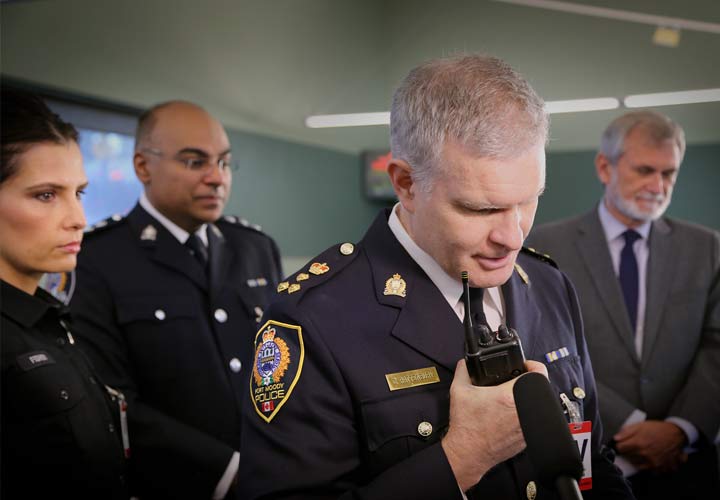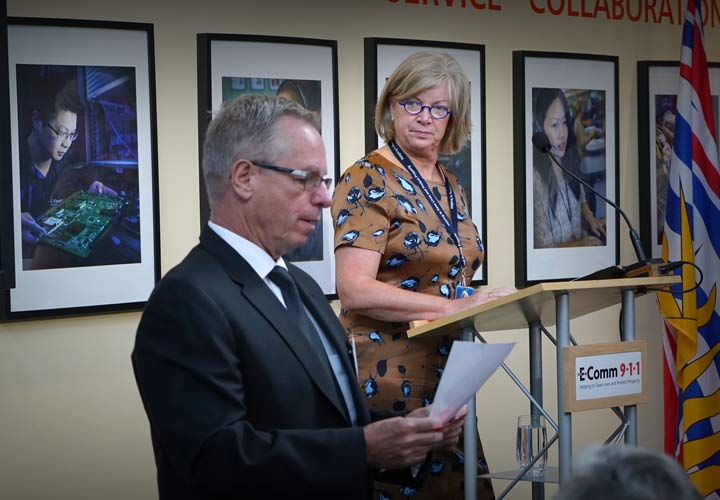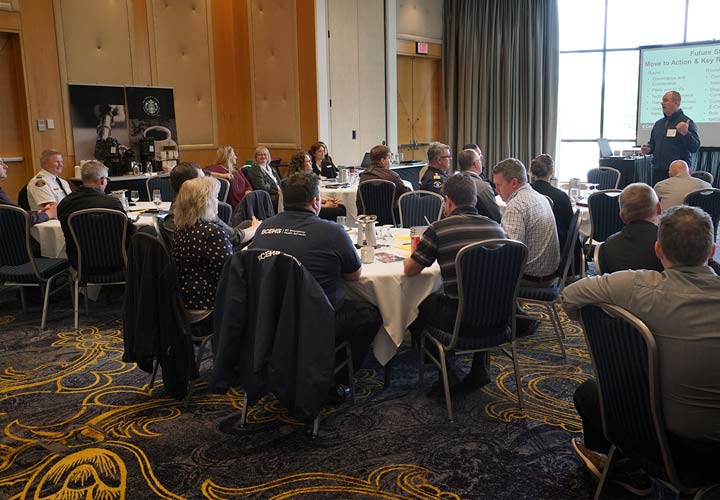Port Moody police
Port Moody police find operational benefits at E-Comm


After months of meticulous planning and preparation, the Port Moody Police Department officially integrated its dispatch with E-Comm on May 10 at 0813hrs.
Following the first radio broadcast from within the E-Comm communication centre, Port Moody Police Chief Chris Rattenbury shared more about the department’s decision to move to E-Comm.
“For me, the convincing factor for wanting to move our dispatch operations to E-Comm was the numerous operational benefits the organization is able to provide its policing partners,” said Chief Rattenbury. “This includes the amount of staff available at any given time to handle sudden increases in 9-1-1 call volume from within our community.”
“For me, the convincing factor for wanting to move our dispatch operations to E-Comm was the numerous operational benefits the organization is able to provide its policing partners.”
Chris Rattenbury
Port Moody Police Chief
Also in attendance for the transition were Port Moody Mayor Mike Clay and Councillor Diana Dilworth. Mayor Clay noted the department has traditionally only had one dispatcher on duty and will now have “a roomful of staff” available to support the police department.
“With the amount of growth our city has seen over the past few years it was becoming more difficult for a smaller department like ours to handle multiple calls with one dispatcher,” said Mayor Clay. “The additional staffing resources we are now able to call upon through our partnership with E-Comm means more resources to support our community, enhancing service for our residents and increasing officer safety.”

As part of the new partnership, E-Comm welcomed Port Moody’s experienced staff including Shelby Bruce, who joined E-Comm with 20 years’ experience as a dispatcher—nine of which were with Port Moody.
“The additional staffing resources we are now able to call upon through our partnership with E-Comm means more resources to support our community, enhancing service for our residents and increasing officer safety.”
Port Moody Mayor Mike Clay
“Change always comes with uncertainty, so the smooth and easy transition has been a welcome surprise,” shared Shelby. “It’s been great to meet new people and share new experiences, and I look forward to the learning opportunities ahead.”
E-Comm is no stranger to providing emergency communication services to the City of Port Moody. The Port Moody Police Department has been using E-Comm’s radio system for more than 15 years and E-Comm has been dispatching for Port Moody Fire-Rescue for 14 years.
“We are proud public safety partners with the City of Port Moody and look forward to providing its first responders and residents with resilient and effective services for years to come,” added David Guscott, E-Comm CEO.

Radio equipment agreements
Radio equipment agreements to provide wide range of solutions for agencies


The Next Generation Radio Program (NGRP) continues to gain momentum as the planned replacement of the regional radio network prepares for a scheduled rollout in the first quarter of 2017. An integral part of the transition to the new network is the acquisition of radios that are compatible with the new system. The NGRP team is currently working on agreements for the provision of radio subscriber equipment, following a Request for Proposal issued in January. It is anticipated this process will be complete later in the summer.
Because the radio system is designed using next generation technology known as Project 25 (P25), it means a variety of radios from different vendors can be used. This provides police, fire and ambulance agencies with the opportunity to choose from a range of approved products to meet their specific requirements—an advantage not possible with the current radio system.
“The priority for the remainder of 2016 will be to ensure the radio sites are fully implemented and the system performs in a manner that meets the standards our public safety partners expect and deserve.”
Steve Mountford, Executive Director
Wireless Transformation
“There is a tremendous benefit in having agencies choose radio equipment that uniquely suits their needs,” explained Richmond Fire Chief John McGowan, chair of the radio user working group (composed of senior representatives from police, fire and ambulance services), that works closely with E-Comm in overseeing the radio replacement project. “What this does is allow us to match individual department services with particular radio features, meaning first responders are getting the best tools to do their jobs, to help serve and protect our communities.”

Another initiative underway related to the NGRP is the development of radio sites as part of the new network’s 44-site design. Over the past several months E-Comm technicians have been focused on site installation work including adding or replacing antennas and installing P25 equipment. Development is scheduled to be complete by the end of the year, with 19 new sites being incorporated into the existing radio system to provide the best possible coverage footprint and in-building penetration.
“Radio site development is one of the most important elements of the NGRP,” explained Steve Mountford, E-Comm’s Executive Director of Wireless Transformation. “The priority for the remainder of 2016 will be to ensure the radio sites are fully implemented and the system performs in a manner that meets the standards our public safety partners expect and deserve. This phase of the project involves a considerable amount of work from the NGRP team, which is committed to ensuring targets are met and the project remains on track.”
CEO Update

In June we were honoured to welcome E-Comm shareholders to our Annual General Meeting (AGM) where we were able to share examples of the outstanding contributions our partners and staff made to public safety in 2015.
These included managing call-taking and dispatch for major police events such as shootings and in-progress robberies and supporting firefighters in battling high-risk fires in both urban and rural settings. We also continued to expand our services, advance our technology and meet our financial objectives in 2015 thanks to the efforts of our staff. E-Comm’s mission is to help save lives and protect property and to build public safety partnerships. Our staff contributed greatly to both our mission and our vision of safer communities in B.C. through excellence in public safety communication. I invite you to learn more about how they are doing that by reading our 2015 Annual Report.
I’d also like to take this opportunity to welcome new members to our Board of Directors appointed by shareholders at the AGM: Pitt Meadows Councillor Bruce Bell, Deputy Minister Becky Denlinger (responsible for Emergency Management BC), Lois Karr (RCMP), Paul Mochrie (City of Vancouver) and Terry Waterhouse (City of Surrey). I’d also like to thank departing directors Gary Bass, Len Garis, Sadhu Johnston and Patrick Quealey for their contribution to E-Comm and to recognize retiring Chair Jocelyn Kelley who has helped to steer our organization over the past six terms. Our congratulations also to newly appointed Board Chair Doug Campbell who we know will help to keep the momentum going through his leadership.
We continue to make great progress with the replacement of the regional radio system with our team focused on completing the development of new radio sites in preparation for agencies to begin transitioning onto the new network in 2017. Our police, fire and ambulance partners will have the ability to choose equipment that best suits their agencies’ unique needs when the new system rolls out, which is just one of the many advantages of moving to the new advanced P25 digital technology. I am also happy to report that due to careful financial oversight and management, no spike in radio levies is anticipated for our shareholders despite the additional features and capacity of the new system. In fact, we anticipate the annual costs will be about the same as the current network.
In the past few months E-Comm continued to contribute to the national dialogue on evolving Canada’s 9-1-1 infrastructure by submitting response papers to the Canadian Radio-television and Telecommunications Commission’s public consultations. We support a coordinated approach to developing a national regulatory framework for what is commonly referred to as Next Generation 9-1-1; to more information-sharing on other potential initiatives such as Wireless Public Alerting and the ability to send emergency alerts to mobile devices within a targeted area. The results of these important consultations will have a direct impact on 9-1-1 centres across Canada and we will continue to participate in their development.
And finally, I would like to take this opportunity to acknowledge a significant milestone within the public safety community—the celebration of 50 years of service by E-Comm’s Director of Fire Services, Dave Mitchell. On behalf of E-Comm and the entire public safety community we thank you for your leadership and expertise in advancing communications across our province.
2015 accomplishments
Board Chair highlights 2015 accomplishments at AGM retrospective


There was one simple, yet powerful word that E-Comm Board Chair Jocelyn Kelley used to describe 2015 and she used it liberally during her June Annual General Meeting (AGM) retrospective… collaboration.
“By its very definition, collaboration represents the efforts of many individuals who come together toward a common purpose,” shared Jocelyn in her opening remarks. “In E-Comm’s case I believe it has been a deep-seated resolve, the kind usually reserved for an underdog, to reach very specific objectives through teamwork, innovation, careful planning and, perhaps most important, a culture that is focused on listening to the customer to help find solutions that support their unique needs.”
For E-Comm, 2015 was a year of many firsts. The emergency communications centre answered its first 9-1-1 call from central Vancouver Island, made a first radio broadcast over the new next generation radio network, successfully managed its first year as the 9-1-1 Primary Public Safety Answer Point for wildfire regions in the northern, southern and central interiors, and during a late-summer windstorm, handled the largest surge of 9-1-1 calls in a compressed time frame in E-Comm’s history. And these are only a few of the many noted accomplishments and milestones.
More than 40 shareholders from municipalities across Metro Vancouver and from the police, fire and ambulance community, attended the June 16 AGM, held each year to carry out the required business of the company under the Business Corporations Act. This includes appointing a new Board of Directors for the upcoming term (2016-2017), receiving the company’s annual financial statements and appointing company auditors.
The Annual General Meeting also marked Jocelyn Kelley announcing she would be retiring as Board Chair after six terms, although she will remain on the Board for one more year.
“I have been beyond honoured to serve as board chair of this organization and it’s been a joy to work with Dave Guscott and the Executive Team and to get to know so many staff over the years,” Jocelyn later said. “Having the chance to double-plug with Operations staff and to learn about the Next Generation Radio Program gives you a special appreciation of the contribution E-Comm makes to public safety.”
For a full overview of E-Comm’s 2015 achievements, performance results and financial overview, find the 2015 Annual Report on ecomm911.ca.
2016-17 Board of Directors
Doug Campbell (Chair)
Independent Director
Councillor Bruce Bell
Maple Ridge/Pitt Meadows
Rebecca (Becky) Denlinger*
Ministry of Public Safety and Solicitor General (*Director Denlinger is Deputy Minister with Emergency Management BC within the Ministry of Transportation and Infrastructure).
Barry Forbes
Independent Director
Mayor Jack Froese
Township of Langley, Cities of Surrey and White Rock
Lois Karr
RCMP
Jocelyn Kelley
Independent Director
Anne Kinvig
Independent Director
Councillor Raymond Louie
Metro Vancouver
Jack McGee
Independent Police Boards (Abbotsford, New Westminster, Port Moody, Transit Police, West Vancouver)
Councillor Bill McNulty
City of Richmond
Paul Mochrie
City of Vancouver
Clayton Pecknold
Ministry of Public Safety and Solicitor General
Karl Preuss
Corporation of Delta / Delta Police Board
Bob Rolls
Vancouver Police Board
Kathy Steegstra
BC Emergency Health Services
Councillor Mary Trentadue
Belcarra, Coquitlam, New Westminster, Port Coquitlam, Port Moody
Mayor Richard Walton
City of North Vancouver, District of North Vancouver, District of West Vancouver, Village of Lions Bay
Terry Waterhouse
Cities of Surrey and White Rock, Township of Langley
enhanced radio communication
Public safety agencies work toward enhanced radio communication


In May, a workshop was held with more than 40 public safety leaders from across Metro Vancouver to discuss radio interoperability issues and develop a regional plan for enhancing cross-agency communication. Key to the discussion was understanding the current state of regional radio interoperability and identifying a desired future state.
With the rollout of the Next Generation Radio Program (NGRP) on target for completion late 2017/early 2018, there is an unprecedented opportunity to help first responders take advantage of the improved communication capabilities that the new radio system offers for both routine and major events through shared talk groups. Although the current radio system has this feature already, a recent survey determined that many responders use less direct tools for communication (e.g., cellphones) to coordinate with other jurisdictions or agencies when radio talk groups would be far more effective. Training is going to be a major focus of the new system so all agencies have the confidence to practise and master improved interoperability with the new radios.
An Interoperability Working Group (IWG) was formed just over a year ago to advance multi-jurisdictional and multi-discipline communication for all E-Comm partner agency services. Made up of experienced agency experts and chaired by Richmond Fire Chief John McGowan, the IWG is building a framework to bring forward interoperability for all radio users on the system. It is a broad cooperative group including municipal police and RCMP, fire services, BC Emergency Health Services and leadership and technical support from E-Comm.
“It’s a huge collaborative effort of all working parties,” explains Chief McGowan. “To be truly interoperable, it means you are able to communicate with who you need, when you need it. That’s the piece we’re looking at advancing.”
The Chief adds the IWG is working hard to facilitate and drive change in our radio system and that E-Comm’s expertise and leadership have been beneficial in driving this world-leading radio system in the name of public safety.


